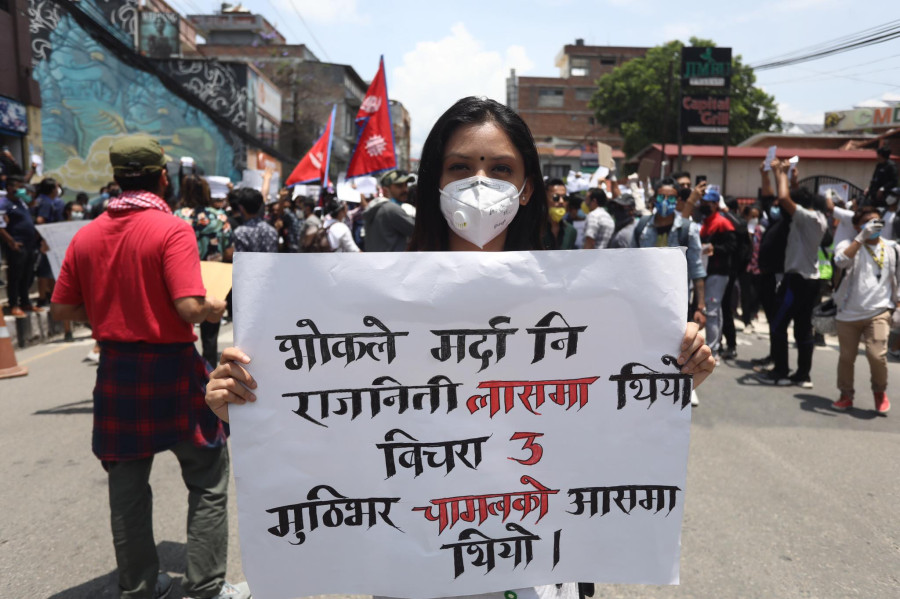National
Youth-led protests against the government’s handling of Covid-19 spread to major cities
On Thursday, over a thousand people in Kathmandu and hundreds more around the country demanded financial transparency and better management of the pandemic from the government.
Shuvam Dhungana
On Thursday, over a thousand people gathered near Bhatbhateni in Kathmandu for a peaceful protest which was organised by youths through different social media platforms demanding that the government improve quarantine conditions, make wider use of polymerase chain reaction (PCR) tests and make public the Covid-19 expenditure report.
In Kathmandu and across the country, young people took to the streets to protest the government’s handling of the Covid-19 pandemic, demand more polymerase chain reaction tests and better quarantine conditions.
This was the second iteration of a series of peaceful protests first organised by youths on Tuesday, when they were met with water cannons and batons. Like then, most of the participants in Thursday’s protest were young people, holding placards that called into question the KP Sharma Oli government’s response to the Covid-19 pandemic. But while Tuesday’s protest was limited to the Capital, by Thursday, the protests had spread across the country.
Eighteen-year-old Pragati Parajuli, one of the protesters who was part of both protests held in Kathmandu, said that the event wasn’t affiliated with any political party.
“The number of participants was huge, compared to the previous protest,” Parajuli told the Post.
Tuesday’s protest had numbered around 150 individuals but Thursday’s protest had grown exponentially in number, with over a thousand attendees.
Protests were also held in other major cities like Pokhara, Biratnagar, Chitwan, Hetauda and Birgunj, while more programmes have been scheduled in other parts of the country for the upcoming week.
Twenty-two-year-old Suyogya Singh of Mahottari, who was one of the organisers of the protest held in Jaleswar, said that almost three dozen people gathered for a peaceful protest on Thursday.
“The protest was carried out following physical distancing protocols and other safety measures,” said Singh. “The police did not interfere and it ended peacefully.”
Young people in Mahottari had gathered to demand an increase in PCR tests, better quarantine conditions and to protest against government incompetence, said Singh.
“We will not stop,” he said. “We will continue the protests until the government listens to our voice.”
In Biratnagar too, over 500 young people had gathered for a protest on Thursday, according to Rishab Sarawagi, a participant. Sarawagi said that their protests were part of a series of protests being held for the past few days along the highways and in front of the Chief District Office.
“The number of people who joined the protest was just around 50 on Wednesday but it rose to 500 on Thursday,” said Sarawagi. “Although police were present during the protest, there was no interference as it was a peaceful protest.”
As elsewhere in the country, the majority of participants were not affiliated to any political parties and had gathered through social media demanding transparency and better management of the pandemic, he said.
But the protest in Kathmandu was met with force from the police.
Protestors had once again gathered near the prime minister’s residence in Baluwatar at 11 am but they were visibly larger in number. Individuals had lined both sides of the street, wearing masks and holding up placards. However, an hour or so into the protest, the police asked them to disperse, as the large number of people made it impossible to maintain physical distance.
According to the Deputy Superintendent Rajkumar KC, police personnel asked protestors to clear the area after the gathered crowd grew larger and protestors were unable to follow physical distancing measures.
“Some protestors, however, started becoming more aggressive so we pushed them back towards the police headquarters in Naxal, fired teargas shells and used water cannons to disperse the youths,” KC told the Post.
None of the protestors, however, resorted to physical violence, with most of the police’s alleged aggression seeming to refer to verbal curses directed at the Oli government.
Many of the youths participating in the protest told the Post that they had decided to join the protest after listening to Prime Minister Oli’s response to lawmakers in Parliament on Wednesday.
In response to questions from parliamentarians on Wednesday, Oli had chosen to repeat misinformation regarding the immune system of Nepalis while ignoring questions about financial transparency.
There has been much criticism of the Oli government's handling of the Covid-19 pandemic, with many pointing to its failure to adequately utilise the lockdown to prepare for the pandemic. Public anger has begun to spill out onto the streets, as business people from New Road too took to the streets on Wednesday, protesting the prolonged lockdown. A nationwide lockdown has been in place since March 24.
A Cabinet meeting on Wednesday, however, decided to relax lockdown in three stages on the recommendation of the Covid-19 Crisis Management Centre, allowing private transport on an odd-even basis and shops to open up.
According to Deputy Inspector General Niraj Bahadur Shahi, spokesperson for the Nepal Police, the protesters are being dispersed not because of their complaints against the government, which is their right, but because they are not following physical distancing measures in light of the Covid-19 pandemic.
“The ongoing protests have increased the risk of Covid-19 infection not only to the public but also to security personnel working in the field under high risk to ensure public safety,” Shahi told the Post. “We are not stopping people from protesting but protesting in a restricted zone with a mass gathering is wrong.”
In Kathmandu, the protestors were well beyond the restricted zone but had difficulties in ensuring physical distance, partly due to the police’s kettling tactic, where they forced the protesters into a small area by barricading both ends of the protest site.



 6.06°C Kathmandu
6.06°C Kathmandu









%20(1).jpg&w=300&height=200)




